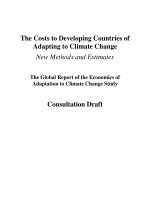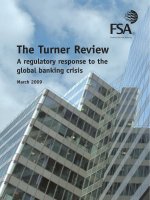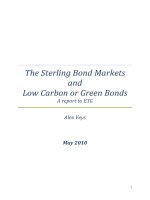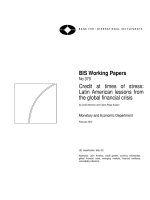The Global Money Markets
Bạn đang xem bản rút gọn của tài liệu. Xem và tải ngay bản đầy đủ của tài liệu tại đây (7.49 MB, 337 trang )
money markets
The Global
THE FRANK J. FABOZZI SERIES
Fixed Income Securities, Second Edition by Frank J. Fabozzi
Focus on Value: A Corporate and Investor Guide to Wealth Creation by James L.
Grant and James A. Abate
Handbook of Global Fixed Income Calculations by Dragomir Krgin
Managing a Corporate Bond Portfolio by Leland E. Crabbe and Frank J. Fabozzi
Real Options and Option-Embedded Securities by William T. Moore
Capital Budgeting: Theory and Practice by Pamela P. Peterson and Frank J. Fabozzi
The Exchange-Traded Funds Manual by Gary L. Gastineau
Professional Perspectives on Fixed Income Portfolio Management, Volume 3 edited
by Frank J. Fabozzi
Investing in Emerging Fixed Income Markets edited by Frank J. Fabozzi and
Efstathia Pilarinu
Handbook of Alternative Assets by Mark J. P. Anson
The Exchange-Traded Funds Manual by Gary L. Gastineau
The Handbook of Financial Instruments edited by Frank J. Fabozzi
money markets
FRANK J. FABOZZI
STEVEN V. MANN
MOORAD CHOUDHRY
John Wiley & Sons, Inc.
The Global
FJF
To my wife, Donna,
and my children, Karly, Patricia, and Francesco
SVM
To my wife Mary and our daughters Meredith and Morgan.
MC
To Olga—like the wild cat of Scotland,
both elusive and exclusive…
The views, thoughts and opinions expressed in this book are those of the authors in their pri-
vate capacity and should not be taken to be representative of any employing institution or
named body. The views of Moorad Choudhry are those of his in his individual capacity and
should not in any way be attributed to JPMorgan Chase Bank, or to Moorad Choudhry as a
representative, officer or employee of JPMorgan Chase Bank.
While every effort has been made to ensure accuracy, no responsibility for loss occasioned to
any person acting or refraining from action as a result of any material in this book can be
accepted by the author(s), publisher or any named person or entity.
Copyright 2002 by Frank J. Fabozzi. All rights reserved.
Published by John Wiley & Sons, Inc., Hoboken, New Jersey
Published simultaneously in Canada
No part of this publication may be reproduced, stored in a retrieval system, or transmitted in
any form or by any means, electronic, mechanical, photocopying, recording, scanning, or oth-
erwise, except as permitted under Section 107 or 108 of the 1976 United States Copyright
Act, without either the prior written permission of the Publisher, or authorization through
payment of the appropriate per-copy fee to the Copyright Clearance Center, Inc., 222 Rose-
wood Drive, Danvers, MA 01923, 978-750-8400, fax 978-750-4470, or on the web at
www.copyright.com. Requests to the Publisher for permission should be addressed to the Per-
missions Department, John Wiley & Sons, Inc., 111 River Street, Hoboken, NJ 07030, 201-
748-6011, fax 201-748-6008, e-mail:
Limit of Liability/Disclaimer of Warranty: While the publisher and author have used their best
efforts in preparing this book, they make no representations or warranties with respect to the accu-
racy or completeness of the contents of this book and specifically disclaim any implied warranties
of merchantability or fitness for a particular purpose. No warranty may be created or extended by
sales representatives or written sales materials. The advice and strategies contained herein may not
be suitable for your situation. You should consult with a professional where appropriate. Neither
the publisher nor author shall be liable for any loss of profit or any other commercial damages,
including but not limited to special, incidental, consequential, or other damages.
For general information on our other products and services, or technical support, please con-
tact our Customer Care Department within the United States at 800-762-2974, outside the
United States at 317-572-3993 or fax 317-572-4002.
Wiley also publishes its books in a variety of electronic formats. Some content that appears in
print may not be available in electronic books.
ISBN: 0-471-22093-0
Printed in the United States of America
10 9 8 7 6 5 4 3 2 1
v
contents
About the Authors vii
Acknowledgements viii
CHAPTER 1
Introduction 1
CHAPTER 2
Money Market Calculations 7
CHAPTER 3
U.S. Treasury Bills 23
CHAPTER 4
Agency Instruments 45
CHAPTER 5
Corporate Obligations: Commercial Paper and Medium-Term Notes 67
CHAPTER 6
Debt Obligations of Financial Institutions 85
CHAPTER 7
Floating-Rate Securities 101
CHAPTER 8
Repurchase and Reverse Repurchase Agreements 119
CHAPTER 9
Short-Term Mortgage-Backed Securities 151
CHAPTER 10
Short-Term Asset-Backed Securities 187
vi
Contents
CHAPTER 11
Futures and Forward Rate Agreements 209
CHAPTER 12
Swaps and Caps/Floors 229
CHAPTER 13
Asset and Liability Management 275
CHAPTER 14
Bank Regulatory Capital 297
INDEX 315
vii
about the authors
Frank J. Fabozzi is editor of the Journal of Portfolio Management and an
adjunct professor of finance at Yale University’s School of Management. He
is a Chartered Financial Analyst and Certified Public Accountant. Dr.
Fabozzi is on the board of directors of the Guardian Life family of funds
and the BlackRock complex of funds. He earned a doctorate in economics
from the City University of New York in 1972 and in 1994 received an
honorary doctorate of Humane Letters from Nova Southeastern University.
Dr. Fabozzi is a Fellow of the International Center for Finance at Yale Uni-
versity. He is an Advisory Analyst for Global Asset Management (GAM)
with responsibilities as Consulting Director for portfolio construction, risk
control, and evaluation.
Steven V. Mann is a Professor of Finance at the Darla Moore School of
Business, University of South Carolina. He earned a doctorate in finance
from the University of Nebraska in 1987. His research interests are in the
area of investments, particularly fixed-income securities and derivatives. He
has published over 35 articles in finance journals and books. Dr. Mann is
an accomplished teacher, winning 16 awards for excellence in teaching. He
is a consultant to investment/commercial banks and has conducted more
than 60 training programs for financial institutions throughout the United
States.
Moorad Choudhry is a vice-president in structured finance services with
JPMorgan Chase in London. He previously worked as a government bond
trader and money markets trader at ABN Amro Hoare Govett Sterling
Bonds Limited, and as a sterling proprietary trader at Hambros Bank Lim-
ited. Moorad is a senior Fellow at the Centre for Mathematical Trading
and Finance, City University Business School, and is also a Fellow of the
Securities Institute. He is Editor of the Journal of Bond Trading and Man-
agement, and has published widely in the field of debt capital markets,
derivatives, and yield curve analysis.
viii
acknowledgements
The authors wish to thank Dean Joel Smith and Professor Greg Niehaus for
their efforts in bringing a Bloomberg terminal to the Moore School of Busi-
ness. The following graduate students at the Moore School of Business
assisted in proofreading the book: Oscar Arostegui, Keshiv Desai, Jeffrey
Dunn, and Brandon Wilson. In addition, we want to thank Michael Ken-
ney for his assistance.
CHAPTER
1
1
Introduction
he money market is traditionally defined as the market for financial
assets that have original maturities of one year or less. In essence, it is
the market for short-term debt instruments. Financial assets traded in
this market include such instruments as U.S. Treasury bills, commercial
paper, some medium-term notes, bankers acceptances, federal agency
discount paper, most certificates of deposit, repurchase agreements,
floating-rate agreements, and federal funds. The scope of the money
market has expanded in recent years to include securitized products
such mortgage-backed and asset-backed securities with short average
lives. These securities, along with the derivative contracts associated
with them, are the subject of this book.
The workings of the money market are largely invisible to the aver-
age retail investor. The reason is that the money market is the province
of relatively large financial institutions and corporations. Namely, large
borrowers (e.g., U.S. Treasury, agencies, money center banks, etc.) seek-
ing short-term funding as well as large institutional investors with excess
cash willing to supply funds short-term. Typically, the only contact retail
investors have with the money market is through money market mutual
funds, known as unit trusts in the United Kingdom and Europe.
Money market mutual funds are mutual funds that invest only in
money market instruments. There are three types of money market funds:
(1) general money market funds, which invest in wide variety of short-term
debt products; (2) U.S. government short-term funds, which invest only in
U.S. Treasury bills or U.S. government agencies; and (3) short-term munic-
ipal funds. Money market mutual funds are a popular investment vehicle
for retail investors seeking a safe place to park excess cash. In Europe, unit
trusts are well-established investment vehicles for retail savers; a number
of these invest in short-term assets and thus are termed money market unit
T
2
THE GLOBAL MONEY MARKETS
trusts. Placing funds in a unit trust is an effective means by which smaller
investors can leverage off the market power of larger investors. In the UK
money market, unit trusts typically invest in deposits, with a relatively
small share of funds placed in money market paper such as government
bills or certificates of deposit. Investors can invest in money market funds
using one-off sums or save through a regular savings plan.
THE MONEY MARKET
The money market is a market in which the cash requirements of market
participants who are long cash are met along with the requirements of
those that are short cash. This is identical to any financial market; the
distinguishing factor of the money market is that it provides for only
short-term cash requirements. The market will always, without fail, be
required because the needs of long cash and short cash market partici-
pants are never completely synchronized. The participants in the market
are many and varied, and large numbers of them are both borrowers
and lenders at the same time. They include:
■
the sovereign authority, including the central government (“Treasury”),
as well as government agencies and the central bank or reserve bank;
■
financial institutions such as the large integrated investment banks,
commercial banks, mortgage institutions, insurance companies, and
finance companies;
■
corporations of all types;
■
individual private investors, such as high net-worth individuals and
small savers;
■
intermediaries such as money brokers, banking institutions, etc.;
■
infrastructure of the marketplace, such as derivatives exchanges.
A money market exists in virtually every country in the world, and all
such markets exhibit the characteristics we describe in this book to some
extent. For instance, they provide a means by which the conflicting needs
of borrowers and lenders can achieve equilibrium, they act as a conduit
for financing of all maturities between one day and one year, and they can
be accessed by individuals, corporations, and governments alike.
In addition to national domestic markets, there is the international
cross-border market illustrated by the trade in Eurocurrencies.
1
Of
1
A Eurocurrency is a currency that is traded outside of its national border, and can
be any currency rather than just a European one.
Introduction
3
course, there are distinctions between individual country markets, and
financial market culture will differ. For instance, the prevailing financial
culture in the United States and United Kingdom is based on a second-
ary market in tradable financial assets, so we have a developed and liq-
uid bond and equity market in these economies. While such an
arrangement also exists in virtually all other countries, the culture in
certain economies such as Japan and (to a lesser extent) Germany is
based more on banking relationships, with banks providing a large pro-
portion of corporate finance. The differences across countries are not
touched upon in this book; rather, it is the similarities in the type of
instruments used that is highlighted.
In developed economies, the money market is large and liquid.
Exhibit 1.1 illustrates the market growth in the United States during the
1990s. Exhibit 1.2 illustrates the breakdown of the United Kingdom
money market by different types of instrument, each of which we cover
in detail in this book.
OVERVIEW OF THE BOOK
In Chapter 2 we cover money market calculations. The intent of this
chapter is to introduce some of the fundamental money market calcula-
tions and conventions that will be used throughout this book, including
day count conventions, as well as the basic formulae for price and yield.
It is essential to understand these calculations since some market instru-
ments are interest bearing while others are discount instruments. More-
over, some instruments calculate interest based on a 360-day year and
some money market securities use a 365-day year.
EXHIBIT 1.1
US Money Market Volumes, $ Billion at Year-End
Source: Federal Reserve Bulletin, 2000, 2001
Instrument 1990 1995 1999
Treasury bills 527 748 723
Federal agency securities 435 845 1,284
Commercial paper 561 675 1,213
Bankers’ acceptances 55 29 21
Fed funds borrowers and repo 409 569 762
Eurodollar borrowings 37 94 167
CDs (min size $100,000) 432 345 634
4
THE GLOBAL MONEY MARKETS
EXHIBIT 1.2
Composition of Sterling Money Markets,
£ Billion Volume Outstanding
* Includes Treasury bills, sell/buy-backs and local authority bills
Source: Bank of England Quarterly Bulletin, Autumn 2001
Chapters 3 and 4 cover short-term debt instruments issued by some
of the largest borrowers in the world—the U.S. Treasury and U.S. fed-
eral agencies. U.S. Treasury bills are considered among the safest and
most liquid securities in the money market. Treasury bill yields serve as
benchmark short-term interest rates for markets around the world.
Agency securities are not typically backed by the full faith and credit of
the U.S. government, as is the case with Treasury bills. However, short-
term agency securities are considered safer than other money market
instruments except U.S. Treasury bills.
Another large borrower of short-term funds is a corporation using
instruments such as commercial paper or short-term medium term
notes. These instruments are the subject of Chapter 5. Commercial
paper is a short-term unsecured promissory note that is issued in the
open market and represents the obligation of the issuing corporation.
An important innovation in this market is asset-backed commercial
paper. Asset-backed commercial paper is commercial paper issued by
either corporations or large financial institutions through a bankruptcy-
remote special purpose corporation and is usually issued to finance the
purchase of receivables and other similar assets. In contrast, a medium-
Introduction
5
term note is a corporate debt instrument with the unique characteristic
that notes are offered continuously to investors by an agent of the
issuer. The maturities of medium-term notes range from 9 months to 30
years or longer. Our focus will be on medium-term notes with original
maturities of one year or less.
The largest group of players in the global money markets are finan-
cial institutions that include depository institutions, investment banks,
and insurance companies. These institutions are simultaneously the big-
gest investors in and issuers of money market instruments. There are
specialized instruments that are unique to this group of borrowers
which include certificates of deposits, bankers acceptances, federal
funds, and funding agreements. Chapter 6 details these instruments.
Chapter 7 describes short-term floating-rate securities. The term
“floating-rate security” covers several different types of instruments
with one common feature: the security’s coupon rate will vary over the
life of the instrument. Approximately, 10% of publicly traded debt
issued worldwide possesses a floating coupon. Floating-rate securities
are the investment of choice for financial institutions whose funding
costs are based on a short-term floating rate.
One of the largest segments of the global money markets is the mar-
ket for repurchase agreements. The repurchase agreement on one hand
is an efficient mechanism used by security dealers to finance bond posi-
tions, and on the other a relatively safe investment opportunity for
investors such as money market funds and corporations. In Chapter 8,
we review repurchase agreements as well as their major uses.
Chapters 9 and 10 cover short-term mortgage-backed and asset-
backed securities. Mortgage-backed securities are securities backed by a
pool of mortgage loans. The pool of loans is referred to as the collateral.
While residential mortgages are by far the largest type of asset that has
been securitized, other assets such as consumer loans, business loans
and receivables have also been securitized. Securities backed by collat-
eral other the mortgage loans are called asset-backed securities. The
largest sectors of the asset-backed securities market in the United States
are securities backed by credit card receivables, auto loans, home equity
loans, manufactured housing loans, and student loans.
Derivatives are financial instruments that derive their value from
some underlying price, index, or interest rate. Money market practitioners
use derivatives to control their exposure to risk by taking positions to
either diminish or enhance this exposure. In Chapters 11 and 12, we
describe these derivative instruments and how they are employed to create
advantageous risk and return patterns. Chapter 11 describes forward con-
tracts, futures contracts, and forward rate agreements. Chapter focuses on
swap contracts and caps/floors.
6
THE GLOBAL MONEY MARKETS
The activity of financial institutions in the money market involves an
activity known as asset and liability management. Asset and liability
management is the term covering tools and techniques used by financial
institutions to manage various types of risk while achieving its profit
objectives by holding the optimal combination of assets and liabilities.
We introduce the fundamental principles of asset and liability manage-
ment in Chapter 13. An appreciation of these concepts and tools is essen-
tial to an understanding of the functioning of the global money markets.
The final chapter of the book, Chapter 14, describes bank regula-
tory capital issues. As noted, the primary players in the global money
markets are large financial institutions, in particular depository institu-
tions. These entities are subject to risk-based capital requirement. The
asset allocation decisions by managers of depository institutions are
largely influenced by how much capital they are compelled to hold and
the capital costs incurred. As a result, these money market participants
must risk-based capital issues regardless of the products they trade or
else they will not fully understand the cost of their own capital or the
return on its use.
CHAPTER
2
7
Money Market Calculations
he intent of this chapter is to introduce some of the fundamental
money market calculations that will be used throughout this book.
We will cover such topics as day count conventions, as well as the basic
formulas for price and yield.
DAY COUNT CONVENTIONS
To those unfamiliar with the workings of financial markets, it may come
as a shock that there is no widespread agreement as to how many days
there are in a year. The procedures used for calculating the number of
days between two dates (e.g., the number of days between the settle-
ment date and the maturity date) are called day count conventions. Day
count conventions vary across different types of securities and across
countries. In this section, we will introduce the day count conventions
relevant to the money markets.
Day Count Basis
The day count basis specifies the convention used to determine the num-
ber of days in a month and in a year. According to the Securities Indus-
try Association Standard Securities Calculation Methods book, Volume
2, the notation used to identify the day count basis is:
1
(number of days in a month)/(number of days in a year)
1
See, Jan Mayle, Standard Securities Calculation Methods, Volume 2 (New York;
Securities Industry Association, 1994).
T
8
THE GLOBAL MONEY MARKETS
Although there are numerous day count conventions used in the
fixed-income markets around the world, there are three basic types.
2
All
day count conventions used worldwide are variations of these three
types. The first type specifies that each month has the actual number of
calendar days in that month and each year has the actual number of cal-
endar days in that year or in a coupon period (e.g., Actual/Actual). The
second type specifies that each month has the actual number of calendar
days in that month but restricts the number of days in each year to a
certain number of days regardless of the actual number of days in that
year (e.g., Actual/360). Finally, the third types restricts both the number
of days in a month and in a year to a certain number of days regardless
of the actual number of days in that month/year (e.g., 30/360). Below
we will define and illustrate the three types of day count conventions.
Actual/Actual
Treasury notes, bonds and STRIPS use an Actual/Actual (in period) day
count convention. When calculating the number of days between two
dates, the Actual/Actual day count convention uses the actual number of
calendar days as the name implies. Let’s illustrate the Actual/Actual day
count convention with a 3.625% coupon, 2-year U.S. Treasury note with
a maturity date of August 31, 2003. The Bloomberg Security Display
(DES) screen for this security is presented in Exhibit 2.1. In the “Security
Information” box on the left-hand side of the screen, we see that the day
count is specified as “ACT/ACT.” From the “Issuance Info” box on the
right-hand side of the screen, we see that interest starts accruing on
August 31, 2001 (the issuance date) and the first coupon date is February
28, 2002. Suppose this bond is traded with a settlement date of Septem-
ber 11, 2001. How many days are there between August 31, 2001 and
September 11, 2001 using the Actual/Actual day count convention?
To answer this question, we simply count the actual number of days
between these two dates.
3
To do this, we utilize Bloomberg’s DCX (Days
Between Dates) function presented in Exhibit 2.2. The function tells us
there are 11 actual days between August 31, 2001 and September 11,
2001.
4
In the same manner, we can also determine the actual number of
calendar days in the full coupon period. A full 6-month coupon period can
only have 181, 182, 183 or 184 calendar days. For example, the actual
number of days between August 31, 2001 and February 28, 2002 is 184.
2
Bloomberg identifies 24 different day count conventions.
3
This is easy to accomplish using software that can convert a Gregorian date (MM/
DD/YY) into a Julian date (the number of days since some base date).
4
Note that the settlement date (September 11) is not counted.
Money Market Calculations
9
EXHIBIT 2.1
Bloomberg Security Description Screen for a
2-Year U.S. Treasury Note
Source: Bloomberg Financial Markets
EXHIBIT 2.2
Bloomberg DCX (Days Between Dates) Screen
Source: Bloomberg Financial Markets
10
THE GLOBAL MONEY MARKETS
EXHIBIT 2.3
Bloomberg Security Description Screen of a
26-Week U.S. Treasury Bill
Source: Bloomberg Financial Markets
Actual/360
Actual/360 is the second type of day count convention. Specifically,
Actual/360 specifies that each month has the same number of days as
indicated by the calendar. However, each year is assumed to have 360
days regardless of the actual number of days in a year. Actual/360 is the
day count convention used in U.S. money markets. Let’s illustrate the
Actual/360 day count with a 26-week U.S. Treasury bill which matures
on March 7, 2002. The Bloomberg Security Display (DES) screen for this
security is presented in Exhibit 2.3. From the “Security Information” box
on the left-hand side of the screen, we see that the day count is specified
as “ACT/360.” Suppose this Treasury bill is purchased with a settlement
date on September 11, 2001 at a price of 98.466. How many days does
this bill have until maturity using the Actual/360 day count convention?
Once again, the question is easily answered using Bloomberg’s DCX
(Days Between Dates) function and specifying the two dates of interest.
This screen is presented in Exhibit 2.4. We see that with a settlement date
of September 11, 2001 there are 177 calendar days until maturity on
March 7, 2002. This can be confirmed by examining the Bloomberg’s YA
(Yield Analysis) screen in Exhibit 2.5. We see that with a settlement date of
September 11, 2001 this Treasury bill has 177 days to maturity. This infor-
mation is located just above the “Price” box in the center of the screen.
Money Market Calculations
11
EXHIBIT 2.4
Bloomberg DCX (Days Between Dates) Screen
Source: Bloomberg Financial Markets
EXHIBIT 2.5
Bloomberg Yield Analysis for a 26-Week U.S. Treasury Bill
Source: Bloomberg Financial Markets
12
THE GLOBAL MONEY MARKETS
When computing the number of days between two dates, Actual/360
and Actual/Actual will give the same answer. What then is the impor-
tance of the 360-day year in the Actual/360 day count? The difference is
apparent when we want to compare, say, the yield on 26-week Treasury
bill with a coupon Treasury which has six months remaining to maturity.
U.S. Treasury bills, like many money market instruments, are discount
instruments. As such, their yields are quoted on a bank discount basis
which determine the bill’s price (which we explain in detail in Chapter
3). The quoted yield on a bank discount basis for a Treasury bill is not
directly comparable to the yield on a coupon Treasury using an Actual/
Actual day count for two reasons. First, the Treasury bill’s yield is based
on a face-value investment rather than on the price. Second, the Treasury
bill yield is annualized according to a 360-day year while a coupon Trea-
sury’s yield is annualized using the actual number of days in a calendar
year (365 or 366). These factors make it difficult to compare Treasury
bill yields with yields on Treasury notes and bonds. We demonstrate how
these yields can be adjusted to make them comparable shortly.
Another variant of this second day count type is the Actual/365. Actual/
365 specifies that each month has the same number of days as indicated by
the calendar and each year is assumed to have 365 days regardless of the
actual number of days in a year. Actual/365 does not consider the extra day
in a leap year. This day count convention is used in the UK money markets.
30/360
The 30/360 day count is the most prominent example of the third type of
day count convention which restricts both the number of days in a
month and in a year to a certain number of days regardless of the actual
number of days in that month/year. With the 30/360 day count all
months are assumed to have 30 days and all years are assumed to have
360 days. The number of days between two dates using a 30/360 day
will usually differ from the actual number of days between the two dates.
To determine the number of days between two dates, we will adopt
the following notation:
Since the 30/360 day count assumes that all months have 30 days,
some adjustments must be made for months having 31 days and Febru-
Y1 = year of the earlier date
M1 = month of the earlier date
D1 = day of the earlier date
Y2 = year of the later date
M2 = month of the later date
D2 = day of the later date
Money Market Calculations
13
ary which has 28 days (29 days in a leap year). The following adjust-
ments accomplish this task:
5
1. If the bond follows the End-of-Month rule
6
and D2 is the last day of
February (the 28th in a non-leap year and the 29th in a leap year) and
D1 is the last day of February, change D2 to 30.
2. If the bond follows the End-of-Month rule and D1 is the last day of
February, change D1 to 30.
3. If D2 is 31 and D1 is 30 or 31, change D2 to 30.
4. If D1 is 31, change D1 to 30.
Once these adjustments are made, the formula for calculating the
number of days between two dates is as follows:
Number of days = [(Y2 − Y1) × 360] + [(M2 − M1) × 30] + (D2 − D1)
To illustrate the 30/360 day count convention, let’s use a 4% coupon
bond which matures on August 15, 2003, issued by Fannie Mae. The
Bloomberg Security Description (DES) screen for this bond is presented in
Exhibit 2.6. We see that in the “Security Information” box that the bond
has a 30/360 day count. Suppose the bond is purchased with a settlement
date of September 11, 2001. We see from the lower left-hand corner of
the screen that the first coupon date is February 15, 2002 and the first
interest accrual date is August 27, 2001. How many days have elapsed in
the first coupon period from August 27, 2001 until the settlement date of
September 11, 2001 using the 30/360 day count convention?
Referring back to the 30/360 day count rule, we see that adjust-
ments 1 through 4 do not apply in this example so no adjustments to
D1 and D2 are required. Accordingly, in this example,
Inserting these numbers into the formula, we find that the number
of days between these two dates is 14, which is calculated as follows:
5
See, Mayle, Standard Securities Calculation Methods, Volume 2.
6
This is the standard convention for bonds in the U.S. and it states that if a bond’s
maturity date falls on the last day of the month so do the bond’s coupon payments.
Y1 = 2001
M1=8
D1=27
Y2 = 2001
M2=9
D2 = 11
14
THE GLOBAL MONEY MARKETS
To check this, let’s employ Bloomberg’s DCX (Days Between Dates)
function presented in Exhibit 2.7. The function tells us there are 14 days
between August 27, 2001 and September 11, 2001 using a 30/360 day
count. Note that the actual number of days between these two dates is 15.
DISCOUNT INSTRUMENTS
Many money market instruments are discount securities (e.g. U.S. Trea-
sury bills, agency discount notes, and commercial paper). Unlike bonds
that pay coupon interest, discount securities are like zero-coupon bonds
in that they are sold at a discount from their face value and are
redeemed for full face value at maturity. Further, most discount securi-
ties use an ACT/360 day count convention. In this section, we discuss
how yields on discount securities are quoted, how discount securities
are priced, and how the yields on discount securities can be adjusted so
that they can be compared to the yields on interest-bearing securities.
EXHIBIT 2.6
Bloomberg Security Description Screen for a
Fannie Mae 2-Year Benchmark Note
Source: Bloomberg Financial Markets
Number of days 2000 2000–()360×[]98–()30×[]11 27–()++=
030 16–()++ 14==
Money Market Calculations
15
EXHIBIT 2.7
Bloomberg DCX (Days Between Dates) Screen
Source: Bloomberg Financial Markets
Yield on a Bank Discount Basis
The convention for quoting bids and offers is different for discount
securities from that of coupon-paying bonds. Prices of discount securi-
ties are quoted in a special way. Bids and offers of these securities are
quoted on a bank discount basis, not on a price basis. The yield on a
bank discount basis is computed as follows:
where
As an example, suppose a Treasury bill with 91 days to maturity
and a face value of $100 trading at a price of $98.5846. The dollar dis-
count, D, is computed as follows:
Y
d
= annualized yield on a bank discount basis (expressed as a
decimal)
D = dollar discount, which is equal to the difference between
the face value and the price
F = face value
t = actual number of days remaining to maturity
Y
d
D
F
-----
360
t
----------
×=
16
THE GLOBAL MONEY MARKETS
D = $100 − $98.5846 = $1.4054
Therefore, the annualized yield on a bank discount basis (expressed as a
decimal)
Given the yield on a bank discount basis, the price of a Treasury bill is
found by first solving the formula for the dollar discount (D) as follows:
D = Y
d
× F × (t/360)
The price is then
price = F − D
As an example, suppose a 91-day bill with a face value of $100 has
a yield on bank discount basis of 5.56%, D is equal to
D = 0.0556 × $100 × 91/360 = $1.4054
Therefore,
price = $100 − $1.4054 = $98.5946
As noted earlier, the quoted yield on a bank discount basis is not a
meaningful measure of the potential return from holding a discount instru-
ment for two reasons. First, the measure is based on a face-value investment
rather than on the actual dollar amount invested. Second, the yield is annu-
alized according to a 360-day rather than a 365-day year, making it difficult
to compare discount yields with the yields on Treasury notes and bonds that
pay interest on a Actual/Actual basis. The use of 360 days for a year is a
common money market convention. Despite its shortcomings as a measure
of return, this is the method that dealers have adopted to quote discount
notes like Treasury bills. Many dealer quote sheets and some other reporting
services provide two other yield measures that attempt to make the quoted
yield comparable to that for a coupon bond and interest-bearing money
market instruments—the CD equivalent yield and the bond equivalent yield.
CD Equivalent Yield
The CD equivalent yield (also called the money market equivalent yield)
makes the quoted yield on a bank discount basis more comparable to
Y
d
$1.4054
$100
---------------------
360
91
----------
× 5.56%==









